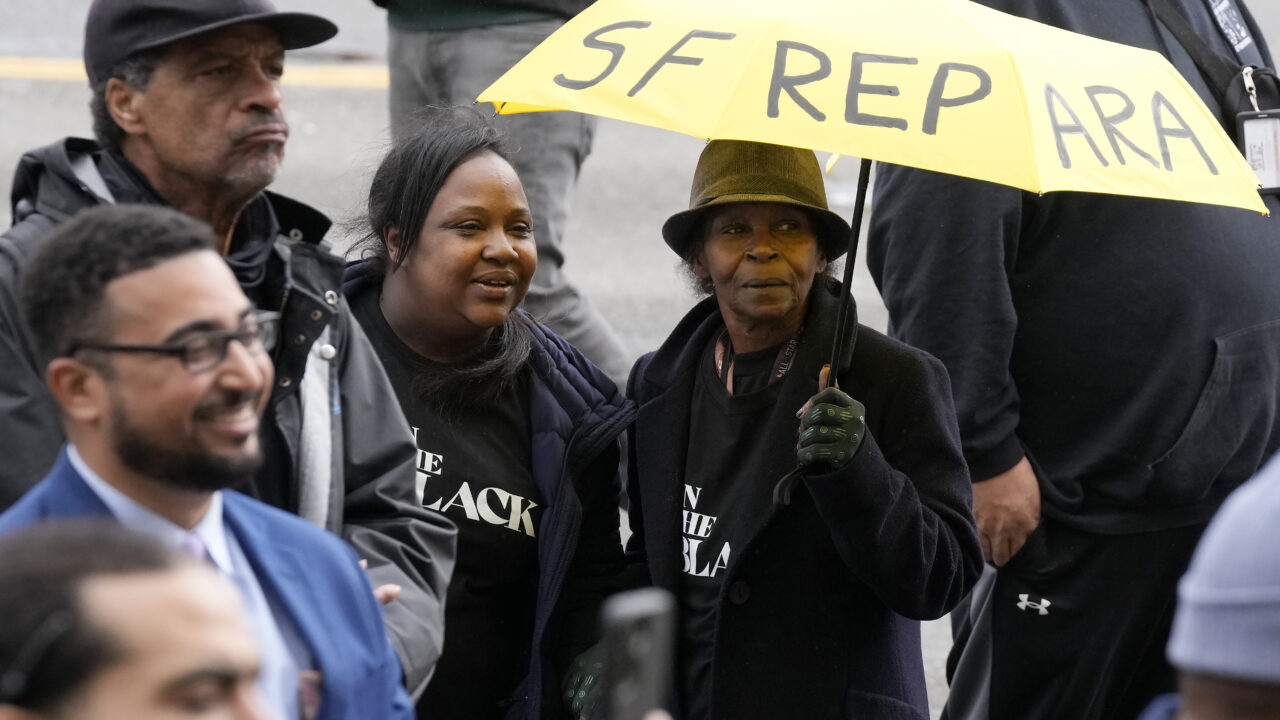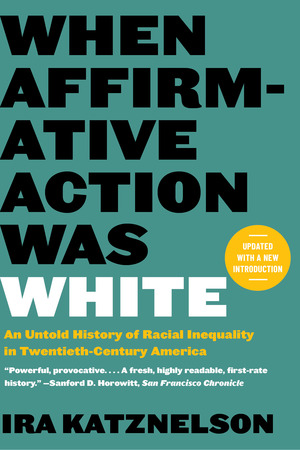The Bill for Inequality Is Due
Ira Katznelson makes the case for reparations in "When Affirmative Action Was White." Pia Harris, with the San Francisco Housing Development Corporation, second from left, and her mother, Adrian Williams, listen to speakers at a reparations rally outside of City Hall in San Francisco, Tuesday, March 14, 2023. (Photo: Jeff Chiu/AP )
Pia Harris, with the San Francisco Housing Development Corporation, second from left, and her mother, Adrian Williams, listen to speakers at a reparations rally outside of City Hall in San Francisco, Tuesday, March 14, 2023. (Photo: Jeff Chiu/AP )
Editor’s Note: Today the conservative majority on the Supreme Court abolished affirmative action. The hypocrisy of this ruling is revealed In Stephen Rohde’s review of When Affirmative Action Was White: An Untold History of Racial Inequality in Twentieth Century America.
On July 1, the California Reparations Task Force will deliver its final report to the state legislature in Sacramento. The document is expected to recommend a number of policies designed to “guarantee restitution, compensation, rehabilitation, satisfaction and non-repetition,” covering everything from affirmative action to the death penalty, from voting rights to health care. Public discussion of the anticipated report has been narrower, focused on the possibility the task force will recommend cash payments for the descendants of slaves as compensation for decades of health disparities, housing discrimination and the mass incarceration and overpolicing of African Americans.
As the possibility of state-level reparations grows more real, a new edition of Ira Katznelson’s classic history of racial inequality, “When Affirmative Action Was White: An Untold History of Racial Inequality in Twentieth Century America,” arrives at a pivotal moment. Republished with an extensive new introduction by the author, the book chronicles how state and federal lawmakers have long crafted assistance programs to benefit white people over Black people. It could very well serve as Exhibit A in any program for redress and recompense.
In the new Introduction, Katznelson, a Bancroft-winning historian at Columbia University, admits that when he began his research, he thought the idea of reparations “ethically on target” but impractical due to public hostility. As a historian, his primary motivation was to set the record straight; as a political scientist, it was to understand the mechanisms that produced certain outcomes; as a citizen, it was to deepen and inform the public debate. But as Katznelson researched the laws and policies that institutionalized white supremacy following the official abolition of slavery, he became a believer and active proponent. The new edition retains the power to persuade and inspire.
In his 1944 assessment of race relations in the United States, “An American Dilemma,” Gunnar Myrdal called the economic situation for African Americans “pathological.” He concluded that “except for a small minority enjoying upper or middle class status, the masses of American Negroes, in the rural South and in the segregated slum quarters in Southern and Northern cities, are destitute. They own little property; even their household goods are mostly inadequate and dilapidated. Their incomes are not only low but irregular. They thus live from day to day and have scant security for the future.”
Katznelson demonstrates that these conditions were allowed to persist and deepen by design. In the 1940s in the rural South, the average income for Black families averaged $565 per year, compared to $1,535 for poor white people. As federal programs lifted white southerners out of poverty, their fellow Black citizens were left out by the powerful southern wing of the Democratic Party in a position to dictate the contours of federal legislation. The result, writes Katznelson, “constituted a program of affirmative action granting white Americans privileged access to state-sponsored economic mobility.”
The result, writes Katznelson, “constituted a program of affirmative action granting white Americans privileged access to state-sponsored economic mobility.”
“When Affirmative Action Was White” devotes separate chapters to the politics and planning of laws such as the Social Security Act of 1935. Because the law excluded farmworkers and domestics, it effectively excluded 65% of African Americans, a number that rose to between 70% and 80% in the South. (Given the agrarian nature of the economy, 40% of white farmers were also excluded).
Although New Deal laws contained anti-discrimination provisions, they were undermined by the white local officials that administered them. “The South’s heritage of bigotry was both reflected and reinforced in patterns of spending and administration,” writes Katznelson. This was not exactly a secret in Washington. In 1940, the Social Security Board reported that during the prior two years, “the number of Negroes to whom aid was granted … was low in proportion to the number who needed assistance.”
Often racist motivations were on full display in debates over New Deal reforms. In the debates over the Fair Labor Standards Act of 1938, which set minimum wages and maximum hours, Florida representative James Mark Wilcox argued against paying “the same wage for the Negro that [is] prescribed for the white man.” He warned that you “cannot put the Negro and the white man on the same basis and get away with it.” Edward Cox of Georgia was appalled that “organized Negro groups” were supporting the new law because it will “render easier the elimination and disappearance of racial and social distinctions.”
Katznelson spends a revealing chapter on the impacts of racial segregation in the military during World War II. Throughout the war, the official Army War College training manual taught that the “Negro is docile, tractable, lighthearted, care free, and good natured… careless, shiftless, irresponsible, and secretive…[and] unmoral, untruthful, and his sense of right doing is relatively inferior.” Almost no Black people served on local draft boards. “What we are doing,” said the director of the Selective Service, Lieutenant Colonel Lewis Hershey in 1944, “is simply transferring discrimination from everyday life into the army.”
By the war’s end, 11% of white men in the military were officers, compared to less than 1% of Black men in uniform. War service, Karznelson writes, “ended with a wider gap between white and blacks, as white access to training and occupational advancement moved ahead at a much more vigorous rate.”
Racial animus carried over into the administration of the GI Bill, arguably the most wide-ranging set of social benefits ever offered by the federal government in a single, comprehensive initiative. Katznelson shows how the program widened the country’s racial gap, a result first documented in a comprehensive 1947 report by Charles G. Bolte and Louis Harris that concluded the GI Bill “had been earmarked ‘For White Veterans Only.’”
“On virtually every social and economic dimension,” Katznelson writes, “blacks and whites are still a nation apart.”
Katznelson explains in detail how “the conversion of bigoted values into racist practices had been built into the law’s design and administration.” Local control strongly discouraged Black people from applying. The path to job placement, loans, unemployment benefits and schooling was tied to local Veteran Administration centers, which Katznelson found were almost entirely staffed by white employees, or through local banks and both public and private educational institutions. The United States Employment Service (USES), meanwhile, which was mandated by the GI Bill to help veterans find jobs, operated through local centers, staffed almost entirely by white job counselors. In the South, Katznelson found, virtually no Black veterans were given access to skilled employment by USES. By October 1946, of the 6,500 former soldiers placed in non-farm jobs, 86% of the skilled and semi-skilled positions were filled by white people, 92% of the unskilled positions by Black people.
The same racial disparities existed for loans under the GI Bill, all of which were administered by local banks. The vast majority of financial institutions refused to approve loans to African Americans — and not just in the South. In New York and the northern New Jersey suburbs, fewer than 100 of the 67,000 mortgages insured by the GI Bill supporting home purchases were granted to non-white people.“ The performance of the GI Bill mocked the promise of fair treatment,” Katznelson writes. “The differential treatment meted out to African Americans sharply curtailed the statute’s powerful egalitarian promise and significantly widened the country’s large racial gap.”
Katznelson begins his last chapter by asking readers to ponder a scenario in which one of the world’s poorest nations transfers more than $100 billion to one of the richest. “This is exactly what happened in the United States,” he writes, “as a result of the cumulative impact of the most important domestic policies of the 1930s and 1940s.” The federal programs of the New Deal initiated “a revolution in the role of government that remade the country’s social structure in dramatic, positive ways. But most blacks were left out… the Gordian knot binding race to class tightened.”
It shouldn’t have been this way. Black and white wages had begun to converge somewhat in the early 1940s, particularly outside the South. But Katznelson demonstrates that, contrary to the myth of wartime wages and economic democracy, “the war-era labor market no longer produced favorable conditions for working-class African Americans.” Because of the dramatic imbalance in government assistance, combined with the combined weight of other forms of institutional racism, “the black-white gap across a whole range of indicators actually began to widen.”
This gap continued to worsen throughout the long postwar boom. By 1984, as most GI Bill mortgages matured, the median white household had a net worth of $39,135, while the comparable figure for Black households was only $3,397— not even 10% of white holdings. By the end of the 20th century, the net worth of a typical white family was $81,000, compared to only $8,000 for Black families.
“On virtually every social and economic dimension,” Katznelson writes, “blacks and whites are still a nation apart” due to “concentrated poverty, poor access to jobs, derisory housing conditions, high rates of incarceration, and challenges to traditional family formation.”
Sixty years ago, on Aug. 28, 1963, in the very first sentence of his historic “I Have a Dream” speech at the March on Washington, Dr. Martin Luther King Jr. invoked the Emancipation Proclamation. He called it “this momentous decree” that came as “a great beacon light of hope to millions of Negro slaves who had been seared in the flames of withering injustice.” He said it “came as a joyous daybreak to end the long night of their captivity.”
King also bemoaned that, “One hundred years later, the Negro lives on a lonely island of poverty in the midst of a vast ocean of material prosperity. One hundred years later the Negro is still languished in the corners of American society and finds himself in exile in his own land. And so we’ve come here today to dramatize a shameful condition. In a sense we’ve come to our nation’s capital to cash a check.”
After another 60 years’ passage since the Emancipation Proclamation, Dr. King’s words still ring tragically true. It is time for America to pay its debt in full.
Your support matters…Independent journalism is under threat and overshadowed by heavily funded mainstream media.
You can help level the playing field. Become a member.
Your tax-deductible contribution keeps us digging beneath the headlines to give you thought-provoking, investigative reporting and analysis that unearths what's really happening- without compromise.
Give today to support our courageous, independent journalists.







You need to be a supporter to comment.
There are currently no responses to this article.
Be the first to respond.